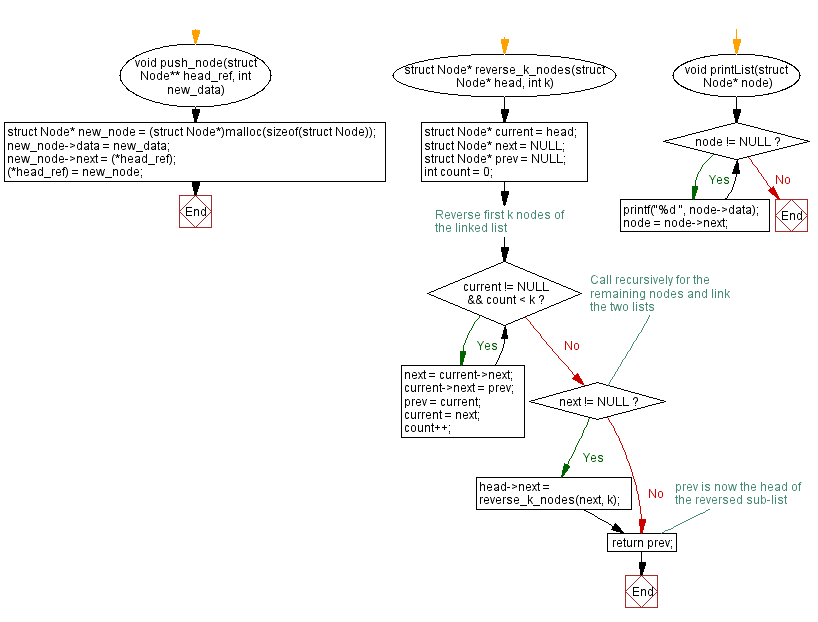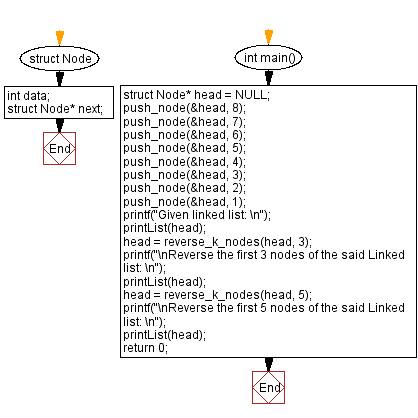C Exercises: Reverse a singly linked list in blocks of size k
36. Block Reversal Variants
Write a C program to reverse a singly linked list starting at the first position in blocks of size k.
Sample Solution:
C Code:
#include<stdio.h>
#include<stdlib.h>
// Structure defining a node in a singly linked list
struct Node {
int data; // Data stored in the node
struct Node* next; // Pointer to the next node
};
// Function to add a new node at the beginning of the linked list
void push_node(struct Node** head_ref, int new_data) {
struct Node* new_node = (struct Node*)malloc(sizeof(struct Node)); // Allocate memory for a new node
new_node->data = new_data; // Assign data to the new node
new_node->next = (*head_ref); // Make the new node point to the current head
(*head_ref) = new_node; // Move the head to point to the new node
}
// Function to reverse the first k nodes of a linked list
struct Node* reverse_k_nodes(struct Node* head, int k) {
struct Node* current = head; // Pointer to the current node
struct Node* next = NULL; // Pointer to store the next node
struct Node* prev = NULL; // Pointer to store the previous node
int count = 0; // Counter to track the number of nodes reversed
/* Reverse the first k nodes of the linked list */
while (current != NULL && count < k) {
next = current->next; // Store the next node
current->next = prev; // Reverse the link of current node to the previous node
prev = current; // Move the prev pointer to the current node
current = next; // Move the current pointer to the next node
count++; // Increment the count of nodes reversed
}
/* Call recursively for the remaining nodes and link the two lists */
if (next != NULL) {
head->next = reverse_k_nodes(next, k); // Recursively reverse the next set of k nodes
}
/* prev is now the head of the reversed sub-list */
return prev;
}
// Function to print the elements of a linked list
void printList(struct Node* node) {
while (node != NULL) {
printf("%d ", node->data); // Print the data of the current node
node = node->next; // Move to the next node
}
}
// Main function to demonstrate reversing the first k nodes of a linked list
int main() {
struct Node* head = NULL; // Initialize an empty linked list
// Adding elements to the linked list
push_node(&head, 8);
push_node(&head, 7);
push_node(&head, 6);
push_node(&head, 5);
push_node(&head, 4);
push_node(&head, 3);
push_node(&head, 2);
push_node(&head, 1);
printf("Given linked list: \n");
printList(head); // Display the original list
head = reverse_k_nodes(head, 3); // Reverse the first 3 nodes of the list
printf("\nReverse the first 3 nodes of the said Linked list: \n");
printList(head); // Display the modified list
head = reverse_k_nodes(head, 5); // Reverse the first 5 nodes of the list
printf("\nReverse the first 5 nodes of the said Linked list: \n");
printList(head); // Display the modified list
return 0;
}
Sample Output:
Given linked list: 1 2 3 4 5 6 7 8 Reverse the first 3 nodes of the said Linked list: 3 2 1 6 5 4 8 7 Reverse the first 5 nodes of the said Linked list: 5 6 1 2 3 7 8 4
Flowchart :


For more Practice: Solve these Related Problems:
- Write a C program to reverse a linked list in blocks of size k using a recursive method.
- Write a C program to reverse every alternate block of k nodes in a linked list while keeping the skipped blocks intact.
- Write a C program to reverse a linked list in blocks of k nodes and leave the last block unchanged if its size is less than k.
- Write a C program to reverse a linked list in blocks of k nodes and then interleave the reversed blocks with the remaining ones.
Go to:
PREV : Sorted Duplicate Removal Challenges.
NEXT : Conditional Removal Challenges.
C Programming Code Editor:
Have another way to solve this solution? Contribute your code (and comments) through Disqus.
What is the difficulty level of this exercise?
